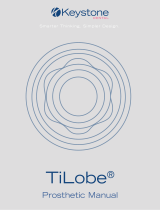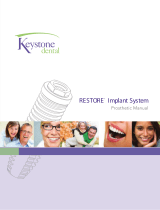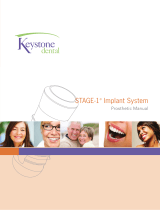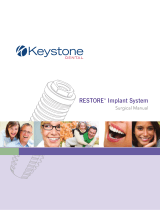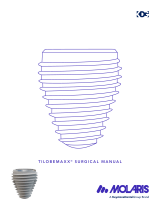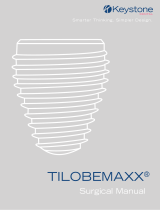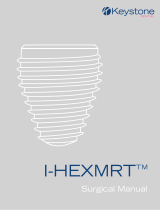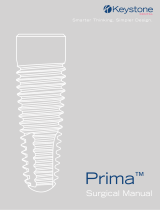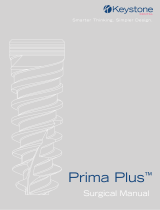
en – Instructions for Use – Axiom® definitive abutments
3/4
If the original packaging is damaged, Anthogyr will
not accept the return of the content.
Non-sterile components:
Anthogyr prosthetic components delivered
non-sterile must be sterilised before use. Anthogyr
recommends following the protocol described in
the cleaning and sterilisaon manual available at
ifu.anthogyr.com or on request from Anthogyr at
the above address.
Aer the sterilisaon was done, asepsis rules must
be followed.
12. Protocol for use
Refer to the brochures listed in the “Further informa-
on” secon for detailed step-by-step instrucons.
Axiom® 2.8
Step 1: Choose the right abutment
▪
Clean and sterilise (See Cleaning and disinfection
and Sterilisation) the try-in abutments.
▪Use the prehensive wrench for try-in abutment
installation in mouth:
1.
Insert the abutment in the wrench aligning the
arrow marked on the wrench with the flat ledge
of the abutment.
2. Place the abutment into the implant:
▪To place the flat spot in the vestibular area,
use the arrow to identify the flat spot.
▪
To place the flat spot in the lingual area, use
the point (located at 180° of the arrow) to
identify the flat spot (if not visible in the
mouth).
3. Press the button on the wrench to release the
abutment.
▪
Place and remove different try-in abutments into
the implant to find the most suitable one.
▪Choose the reference of the impacted abutment
according to the try-in abutment selected.
Step 2: Place the aesthec impacted abutment
▪
Remove the abutment from the sterile packaging
on the sterile field.
▪
Before placing the abutment, ensure that the con-
nection is free of any fluid or other substance that
may compromise the proper fit of the prosthetic
component in the implant.
▪Using the prehensive wrench, secure the abut-
ment before transporting it in the patient mouth:
follow the same steps as in “Step 1: Choose the
right abutment”.
▪Before impaction of the definitive restoration
in mouth, make a local anaesthesia if necessary.
▪Select the impaction tip which is adapted to the
abutment:
▪
In case of installation of a prosthesis cemented
inside of the mouth, use one of the 2 adapted
impaction tips, depending on the angulation of
the abutment. For 15 and 23° angulated abut-
ments, position the laser marking of the tip on
the flat surface of the abutment.
▪
In case of installation of a prosthesis cemented
outside of the mouth, use the impaction tip
adapted to the incisors to secure the prosthesis
in the implant. For effective transmission of the
impaction force, place the impaction tip firmly
against the incisor edge of the prosthesis and
as close to the implant axis as possible.
▪Position the flat ledge of the abutment in the
vestibule (or in the lingual surface in the case of
straight abutments) using the prehensive wrench.
▪
Tighten the impaction tip on the SAFE LOCK®, ad-
just the motor speed to 10 000 rpm maximum.
Position the tip on the abutment or the prosthesis
before pressing the pedal and wait for 5 strokes.
Step 3: Protect the abutment during healing
phase
▪
Clean and sterilise (See Cleaning and disinfection
and Sterilisation) the protection cap.
▪Clean the abutment ’s coronary part thoroughly.
▪Seal the protection cap onto the abutment using
temporary cement.
Step 4: Place the crown onto the abutment
▪Use the castable coping as support for making
the wax crown on the master model.
▪Make the metallic crown according to current
casting and finishing protocols.
▪Remove the protection cap.
▪Cement the crown onto the abutment.
Axiom® BL
Choose the right abutment
▪
Clean and sterilise (See Cleaning and disinfection
and Sterilisation) the try-in abutments.
▪Secure the try-in abutments before transporting
it in the patient mouth.
▪
Place and remove different try-in abutments into
the implant to find the most suitable one.
▪Choose the reference of the definitive abutment
according to the try-in abutment selected.
A. Protocol for aesthec abutments
▪
Clean and sterilise (See Cleaning and disinfection
and Sterilisation) the abutment and the definitive
screw.
▪Before screwing the abutment, ensure that the
connection is free of any fluid or other substance
that may compromise the proper fit of the pros-
thetic component in the implant.
▪
Place the abutment into the implant with Axiom®
BL abutment gripper if needed.
▪Tighten the definitive screw to 25 N.cm with the
hexagonal wrench and the prosthetic dynamo-
metric wrench or with the hexagonal mandrel and
the TORQ CONTROL®.
▪Close the screw channel.
▪Cement the restoration onto the abutment.
B. Protocol for straight and angulated standard
abutments
Step B1: Place the standard abutment
▪Before screwing the abutment, ensure that the
connection is free of any fluid or other substance
that may compromise the proper fit of the pros-
thetic component in the implant.
▪
Place the abutment into the implant with Axiom®
BL abutment gripper if needed.
▪Tighten the definitive screw to 25 N.cm with the
hexagonal wrench and the prosthetic dynamo-
metric wrench or with the hexagonal mandrel and
the TORQ CONTROL®.
▪Close the screw channel.
Step B2: Protect the standard abutment during
healing phase
▪
Clean and sterilise (See Cleaning and disinfection
and Sterilisation) the protection cap.
▪Clean the abutment’s coronary part thoroughly.
▪Seal the protection cap onto the abutment’s cor-
onary part using temporary cement.
Step B3: Place the restoraon onto the standard
abutment
▪
Use the castable coping as support for making the
wax restoration on the master model:
▪Use indexed castable coping for single-unit res-
toration.
▪
Use non-indexed castable coping for multiple-unit
restoration.
▪Make the metallic restoration according to cur-
rent casting and finishing protocols.
▪Remove the protection cap.
▪Cement the restoration onto the abutment.
Axiom® TL
▪
Clean and sterilise (See Cleaning and disinfection
and Sterilisation) the prosthesis and the definitive
screw.
▪Before screwing the prosthesis, ensure that the
connection is free of any fluid or other substance
that may compromise the proper fit of the pros-
thetic component in the implant.
▪Place the prosthesis into the implant.
▪Tighten the definitive screw to 25 N.cm with the
hexagonal wrench and the prosthetic dynamo-
metric wrench or with the hexagonal mandrel and
the TORQ CONTROL®.
▪Close the screw channel.
13. Healing phase
The protecon caps must be placed in sub-occlusion.
14. Lifespan of products
The Try-in abutments can be reused during 5 years,
except in cases where there are signs of deterio-
raon (illegibility of markings or markers, signs of
corrosion, etc.).
Other components are for single-use.
15. Further informaon
For more informaon on the use of Anthogyr prod-
ucts, please contact your local Anthogyr sales rep-
resentave or contact Anthogyr customer service
or visit ifu.anthogyr.com and www.anthogyr.com.
For more specic informaon on the Axiom® den-
ive abutments, please refer to:











